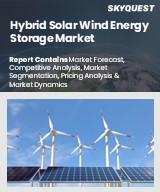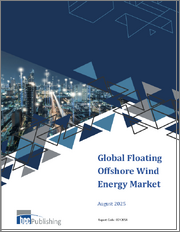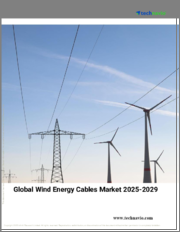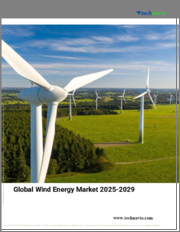
|
시장보고서
상품코드
1570766
세계의 공중 풍력에너지 시장 : 기술별, 컴포넌트별, 용도별, 최종 사용자별 - 예측(2025-2030년)Airborne Wind Energy Market by Technology (Bladed Rotors Systems, Kite-Based Systems), Component (Energy Generators, Tethers), Application, End-User - Global Forecast 2025-2030 |
||||||
공중 풍력에너지 시장은 2023년 1억 5,898만 달러로 평가되었고, 2024년에는 1억 7,266만 달러로 추정되며, CAGR 9.60%로 성장할 전망이고, 2030년에는 3억 210만 달러에 달할 것으로 예상됩니다.
공중 풍력에너지(AWE)는 기존의 풍력 터빈에 비해 높은 고도로 가동하는 연이나 드론 등의 공기역학적 구조를 이용하여 풍력을 이용하는 것입니다. 이 혁신적인 접근 방식은 더 강하고 안정적인 바람을 포착하고 효율성을 높입니다. AWE의 필요성은 기후 변화를 완화하고 화석연료에 대한 의존도를 줄이기 위한 지속가능한 에너지 솔루션에 대한 수요 증가로 인한 것입니다. AWE 용도에는 원격지에서의 전력 공급, 그리드 지원, 기존 신재생 에너지 시스템으로의 통합 등이 있습니다. 최종 용도는 주택용 및 산업용 발전에서 비전화지역 및 재해지역으로의 전력공급까지 다양합니다. 주요 성장 요인으로는 기술 진보, 환경 의식 증가, 정부 지원 정책, 에너지 다양화 추구 등이 있습니다. 기회는 에너지 효율 향상을 위한 기술 혁신, 프로젝트 규모 확대를 위한 전략적 파트너십, 강풍 지역에서의 운전 구역 확대 등에 있습니다. 그러나 규제 장애물, 제한된 자금, 공역 안전성에 대한 우려, 장기적인 성능과 신뢰성 불확실성 등의 문제가 있습니다. 이를 극복하기 위해서는 재료, 설계 최적화, 제어 시스템 강화에 대한 집중적인 조사가 필요합니다. 또한 항공우주 규제 기관과의 협력을 촉진함으로써 수용을 가속화 할 수 있습니다. 가볍고 내구성 있는 재료를 개발하기 위한 연구개발 투자는 운영 효율성에 혁명을 일으킬 수 있습니다. AWE 시장은 아직 막 시작되었기 때문에 성장 가능성이 높고 신재생 에너지 인프라가 확립되지 않은 신흥 시장에 큰 기회가 있습니다. AWE 시장의 성격은 역동적이고 혁신적인 주도형이기 때문에 견고한 지적 재산 전략을 가진 조기 채용 기업이 경쟁 우위를 확보할 수 있음을 시사합니다. 기업가 및 투자자들은 틈새 및 대규모 용도 모두에 대응하는 탄력적인 비즈니스 모델 구축에 주력하고 진화하는 에너지 상황에서 전략적 위치를 수립해야 합니다.
| 주요 시장 통계 | |
|---|---|
| 기준년(2023년) | 1억 5,898만 달러 |
| 예측년(2024년) | 1억 7,266만 달러 |
| 예측년(2030년) | 3억210만 달러 |
| CAGR(%) | 9.6% |
시장 역학 : 급속히 진화하는 공중 풍력에너지 시장의 주요 시장 인사이트 공개
공중 풍력에너지 시장은 수요 및 공급의 역동적인 상호 작용에 의해 변모하고 있습니다. 이러한 시장 역학의 진화를 이해함으로써 기업은 충분한 정보를 바탕으로 투자결정, 전략적 결정 정밀화, 새로운 비즈니스 기회 획득에 대비할 수 있습니다. 이러한 동향을 종합적으로 파악함으로써 기업은 정치적, 지리적, 기술적, 사회적, 경제적 영역에 걸친 다양한 리스크를 경감할 수 있어 소비자 행동이나 그것이 제조 비용 및 구매 추세에 미치는 영향에 대해서도 더 명확하게 이해할 수 있습니다.
Porter's Five Forces : 공중 풍력에너지 시장을 탐색하는 전략 도구
Porter's Five Forces 프레임 워크는 공중 풍력에너지 시장 경쟁 구도를 이해하는 중요한 도구입니다. Porter's Five Forces 프레임 워크는 기업의 경쟁을 평가하고 전략적 기회를 탐구하는 명확한 기술을 설명합니다. 이 프레임 워크는 기업이 시장 내 세력도를 평가하고 신규 사업의 수익성을 판단하는 데 도움이 됩니다. 이러한 인사이트를 통해 기업은 자사의 강점을 활용하고 약점을 해결하고 잠재적인 과제를 피할 수 있으며 보다 강인한 시장에서의 포지셔닝을 확보할 수 있습니다.
PESTLE 분석 : 공중 풍력에너지 시장에서 외부로부터의 영향 파악
외부 거시 환경 요인은 공중 풍력에너지 시장의 성과 역학을 형성하는데 매우 중요한 역할을 합니다. 정치적, 경제적, 사회적, 기술적, 법적, 환경적 요인 분석은 이러한 영향을 탐색하는 데 필요한 정보를 설명합니다. PESTLE 요인을 조사함으로써 기업은 잠재적인 위험과 기회를 더 잘 이해할 수 있습니다. 이 분석을 통해 기업은 규제, 소비자 선호, 경제 동향의 변화를 예측하고 앞으로 예상되는 적극적인 의사 결정을 할 준비를 할 수 있습니다.
시장 점유율 분석 : 공중 풍력에너지 시장 경쟁 구도 파악
공중 풍력에너지 시장의 상세한 시장 점유율 분석을 통해 공급업체의 성과를 종합적으로 평가할 수 있습니다. 기업은 수익, 고객 기반, 성장률 등 주요 지표를 비교하여 경쟁 포지셔닝을 밝힐 수 있습니다. 이 분석을 통해 시장 집중, 세분화 및 통합 동향을 밝혀내고 공급업체는 경쟁이 치열해짐에 따라 자사의 지위를 높이는 전략적 의사 결정을 내리는 데 필요한 지식을 얻을 수 있습니다.
FPNV 포지셔닝 매트릭스 : 공중 풍력에너지 시장에서 공급업체의 성능 평가
FPNV 포지셔닝 매트릭스는 공중 풍력에너지 시장에서 공급업체를 평가하는 중요한 도구입니다. 이 행렬을 통해 비즈니스 조직은 공급업체의 비즈니스 전략과 제품 만족도를 기준으로 평가하여 목표에 맞는 충분한 정보를 바탕으로 의사 결정을 내릴 수 있습니다. 네 가지 사분면을 통해 공급업체를 명확하고 정확하게 세분화하여 전략 목표에 가장 적합한 파트너 및 솔루션을 파악할 수 있습니다.
전략 분석 및 추천 : 공중 풍력에너지 시장에서 성공을 위한 길 그리기
공중 풍력에너지 시장의 전략 분석은 세계 시장에서의 프레즌스 강화를 목표로 하는 기업에 필수적입니다. 주요 자원, 능력 및 성과 지표를 검토함으로써 기업은 성장 기회를 파악하고 개선을 위해 노력할 수 있습니다. 이 접근법을 통해 경쟁 구도에서 과제를 극복하고 새로운 비즈니스 기회를 활용하여 장기적인 성공을 거둘 수 있는 체제를 마련할 수 있습니다.
이 보고서는 주요 관심 분야를 포괄하는 종합적인 시장 분석을 제공합니다.
1. 시장 침투도 : 현재 시장 환경에 대해 상세히 검토합니다.
2. 시장 개척도 : 신흥 시장의 성장 기회를 파악하고, 기존 부문에서의 확장 가능성을 평가하며, 미래 성장을 위한 전략적 로드맵을 설명합니다.
3. 시장 다양화 : 최근 제품 출시, 미개척 지역, 업계의 주요 진보, 시장을 형성하는 전략적 투자를 분석합니다.
4. 경쟁 평가 및 정보 : 경쟁 구도를 철저히 분석하고 시장 점유율, 사업 전략, 제품 포트폴리오, 인증, 규제 당국 승인, 특허 동향, 주요 기업의 기술 진보 등을 조사했습니다.
5. 제품 개발 및 혁신 : 미래 시장 성장을 가속할 것으로 예상되는 최첨단 기술, 연구개발 활동, 제품 혁신을 강조합니다.
또한 이해관계자가 충분한 정보를 바탕으로 의사결정을 할 수 있도록 중요한 질문에도 답변하고 있습니다.
1. 현재 시장 규모 및 향후 성장 예측은?
2. 최고의 투자 기회를 제공하는 제품, 지역은 어디입니까?
3. 시장을 형성하는 주요 기술 동향 및 규제의 영향은?
4. 주요 벤더의 시장 점유율 및 경쟁 포지션은?
5. 벤더 시장 진입 및 철수 전략의 원동력이 되는 수익원과 전략적 기회는 무엇인가?
목차
제1장 서문
제2장 조사 방법
제3장 주요 요약
제4장 시장 개요
제5장 시장 인사이트
- 시장 역학
- 성장 촉진요인
- 토지의 이용가능량이 제한되어 휴대용으로 방해받지 않는 신재생 에너지 솔루션의 필요성 증가
- 에너지 소비가 증가함에 따라 공중 풍력에너지와 같은 다양한 신재생 에너지원에 대한 관심 고조
- 신재생 에너지 프로젝트에 대한 정부의 지원정책과 보조금
- 억제요인
- 높은 초기 비용 및 긴 투자 회수 기간으로 잠재적인 투자자가 멀어짐
- 기회
- 공중 풍력에너지 솔루션의 상업화를 가속화하는 공동 프로젝트와 파트너십
- 오프쇼어와 원격지에 대한 설치의 확대에 의해 공중 풍력에너지 시스템 수요 증가
- 과제
- 공중 풍력에너지 기술의 보급에 수반하는 규제와 환경에 대한 우려
- 성장 촉진요인
- 시장 세분화 분석
- Porter's Five Forces 분석
- PESTLE 분석
- 정치
- 경제
- 사회
- 기술
- 법률
- 환경
제6장 공중 풍력에너지 시장 : 기술별
- 서문
- 블레이드 로터 시스템
- 수평축
- 연 기반의 시스템
- 경질 연
- 소프트 카이트
- 멀티 라인 소프트 카이트
- 싱글 라인 소프트 카이트
제7장 공중 풍력에너지 시장 : 컴포넌트별
- 서문
- 에너지 발전기
- 공중 발전기
- 지상 설치형 발전기
- 테더링
제8장 공중 풍력에너지 시장 : 용도별
- 서문
- 상업용
- 유틸리티
제9장 공중 풍력에너지 시장 : 최종 사용자별
- 서문
- 상업용
- 에너지 공급업자
- 군사
제10장 아메리카의 공중 풍력에너지 시장
- 서문
- 아르헨티나
- 브라질
- 캐나다
- 멕시코
- 미국
제11장 아시아태평양의 공중 풍력에너지 시장
- 서문
- 호주
- 중국
- 인도
- 인도네시아
- 일본
- 말레이시아
- 필리핀
- 싱가포르
- 한국
- 대만
- 태국
- 베트남
제12장 유럽, 중동 및 아프리카의 공중 풍력에너지 시장
- 서문
- 덴마크
- 이집트
- 핀란드
- 프랑스
- 독일
- 이스라엘
- 이탈리아
- 네덜란드
- 나이지리아
- 노르웨이
- 폴란드
- 카타르
- 러시아
- 사우디아라비아
- 남아프리카
- 스페인
- 스웨덴
- 스위스
- 터키
- 아랍에미리트(UAE)
- 영국
제13장 경쟁 구도
- 시장 점유율 분석(2023년)
- FPNV 포지셔닝 매트릭스(2023년)
- 경쟁 시나리오 분석
- 전략 분석 및 제안
The Airborne Wind Energy Market was valued at USD 158.98 million in 2023, expected to reach USD 172.66 million in 2024, and is projected to grow at a CAGR of 9.60%, to USD 302.10 million by 2030.
Airborne Wind Energy (AWE) involves harnessing wind power using aerodynamic structures such as kites and drones, which operate at higher altitudes compared to traditional wind turbines. This innovative approach captures stronger and more consistent winds, enhancing efficiency. The necessity of AWE stems from the growing demand for sustainable energy solutions to mitigate climate change and reduce dependence on fossil fuels. Applications of AWE include remote power supply, grid support, and integration into existing renewable energy systems. The end-use scope ranges from electricity generation for residential and industrial purposes to providing power in off-grid and disaster-stricken areas. Key growth influences include technological advancements, increasing environmental consciousness, supportive government policies, and the quest for energy diversification. Opportunities lie in technological innovation for improved energy efficiency, strategic partnerships for scaling projects, and expanding operational zones in high-wind regions. However, challenges exist in the form of regulatory hurdles, limited funding, and concerns over airspace safety along with uncertainties in long-term performance and reliability. To overcome these, intensive research into materials, design optimization, and enhanced control systems is necessary. Moreover, fostering collaboration with aerospace regulatory bodies can accelerate acceptance. Investment in R&D to develop lightweight and durable materials could revolutionize operational efficiency. As the market is still nascent, it holds a high potential for growth, with substantial opportunities in emerging markets which lack established renewable infrastructure. The nature of the AWE market is dynamic and innovation-driven, suggesting that early adopters with robust intellectual property strategies can secure competitive advantages. Entrepreneurs and investors should focus on building resilient business models that cater to both niche and large-scale applications, thus positioning themselves strategically in the evolving energy landscape.
| KEY MARKET STATISTICS | |
|---|---|
| Base Year [2023] | USD 158.98 million |
| Estimated Year [2024] | USD 172.66 million |
| Forecast Year [2030] | USD 302.10 million |
| CAGR (%) | 9.6% |
Market Dynamics: Unveiling Key Market Insights in the Rapidly Evolving Airborne Wind Energy Market
The Airborne Wind Energy Market is undergoing transformative changes driven by a dynamic interplay of supply and demand factors. Understanding these evolving market dynamics prepares business organizations to make informed investment decisions, refine strategic decisions, and seize new opportunities. By gaining a comprehensive view of these trends, business organizations can mitigate various risks across political, geographic, technical, social, and economic domains while also gaining a clearer understanding of consumer behavior and its impact on manufacturing costs and purchasing trends.
- Market Drivers
- The increasing need for portable and less intrusive renewable energy solutions due to limited land availability
- Rising energy consumption demands propelling interest in diversified renewable energy sources like airborne wind energy
- Supportive government policies and subsidies for renewable energy projects
- Market Restraints
- High initial costs and long return on investment periods deterring potential investors
- Market Opportunities
- Collaborative projects and partnerships accelerating the commercialization of airborne wind energy solutions
- Expanding offshore and remote area installations boosting the demand for airborne wind energy systems
- Market Challenges
- Regulatory and environmental concerns associated with widespread adoption of airborne wind energy technologies
Porter's Five Forces: A Strategic Tool for Navigating the Airborne Wind Energy Market
Porter's five forces framework is a critical tool for understanding the competitive landscape of the Airborne Wind Energy Market. It offers business organizations with a clear methodology for evaluating their competitive positioning and exploring strategic opportunities. This framework helps businesses assess the power dynamics within the market and determine the profitability of new ventures. With these insights, business organizations can leverage their strengths, address weaknesses, and avoid potential challenges, ensuring a more resilient market positioning.
PESTLE Analysis: Navigating External Influences in the Airborne Wind Energy Market
External macro-environmental factors play a pivotal role in shaping the performance dynamics of the Airborne Wind Energy Market. Political, Economic, Social, Technological, Legal, and Environmental factors analysis provides the necessary information to navigate these influences. By examining PESTLE factors, businesses can better understand potential risks and opportunities. This analysis enables business organizations to anticipate changes in regulations, consumer preferences, and economic trends, ensuring they are prepared to make proactive, forward-thinking decisions.
Market Share Analysis: Understanding the Competitive Landscape in the Airborne Wind Energy Market
A detailed market share analysis in the Airborne Wind Energy Market provides a comprehensive assessment of vendors' performance. Companies can identify their competitive positioning by comparing key metrics, including revenue, customer base, and growth rates. This analysis highlights market concentration, fragmentation, and trends in consolidation, offering vendors the insights required to make strategic decisions that enhance their position in an increasingly competitive landscape.
FPNV Positioning Matrix: Evaluating Vendors' Performance in the Airborne Wind Energy Market
The Forefront, Pathfinder, Niche, Vital (FPNV) Positioning Matrix is a critical tool for evaluating vendors within the Airborne Wind Energy Market. This matrix enables business organizations to make well-informed decisions that align with their goals by assessing vendors based on their business strategy and product satisfaction. The four quadrants provide a clear and precise segmentation of vendors, helping users identify the right partners and solutions that best fit their strategic objectives.
Strategy Analysis & Recommendation: Charting a Path to Success in the Airborne Wind Energy Market
A strategic analysis of the Airborne Wind Energy Market is essential for businesses looking to strengthen their global market presence. By reviewing key resources, capabilities, and performance indicators, business organizations can identify growth opportunities and work toward improvement. This approach helps businesses navigate challenges in the competitive landscape and ensures they are well-positioned to capitalize on newer opportunities and drive long-term success.
Key Company Profiles
The report delves into recent significant developments in the Airborne Wind Energy Market, highlighting leading vendors and their innovative profiles. These include AeroVironment Inc, Alphabet Inc, Ampyx Power, EDF Renewables, EnerKite GmbH, General Electric, Iberdrola, Joby Aviation, Kitepower, KPS (Kite Power Solutions), Magenn Power Inc, Makani Technologies LLC, NextEra Energy, Inc, Nordex SE, Siemens Gamesa Renewable Energy, SkySails Group GmbH, Suzlon Energy Ltd, TwingTec AG, Vestas Wind Systems A/S, and Windlift.
Market Segmentation & Coverage
This research report categorizes the Airborne Wind Energy Market to forecast the revenues and analyze trends in each of the following sub-markets:
- Based on Technology, market is studied across Bladed Rotors Systems and Kite-Based Systems. The Bladed Rotors Systems is further studied across Horizontal Axis. The Kite-Based Systems is further studied across Rigid Kites and Soft Kites. The Soft Kites is further studied across Multi-Line Soft Kites and Single-Line Soft Kites.
- Based on Component, market is studied across Energy Generators and Tethers. The Energy Generators is further studied across Airborne Generators and Ground-Based Generators.
- Based on Application, market is studied across Commercial and Utility-Scale.
- Based on End-User, market is studied across Commercial, Energy Providers, and Military.
- Based on Region, market is studied across Americas, Asia-Pacific, and Europe, Middle East & Africa. The Americas is further studied across Argentina, Brazil, Canada, Mexico, and United States. The United States is further studied across California, Florida, Illinois, New York, Ohio, Pennsylvania, and Texas. The Asia-Pacific is further studied across Australia, China, India, Indonesia, Japan, Malaysia, Philippines, Singapore, South Korea, Taiwan, Thailand, and Vietnam. The Europe, Middle East & Africa is further studied across Denmark, Egypt, Finland, France, Germany, Israel, Italy, Netherlands, Nigeria, Norway, Poland, Qatar, Russia, Saudi Arabia, South Africa, Spain, Sweden, Switzerland, Turkey, United Arab Emirates, and United Kingdom.
The report offers a comprehensive analysis of the market, covering key focus areas:
1. Market Penetration: A detailed review of the current market environment, including extensive data from top industry players, evaluating their market reach and overall influence.
2. Market Development: Identifies growth opportunities in emerging markets and assesses expansion potential in established sectors, providing a strategic roadmap for future growth.
3. Market Diversification: Analyzes recent product launches, untapped geographic regions, major industry advancements, and strategic investments reshaping the market.
4. Competitive Assessment & Intelligence: Provides a thorough analysis of the competitive landscape, examining market share, business strategies, product portfolios, certifications, regulatory approvals, patent trends, and technological advancements of key players.
5. Product Development & Innovation: Highlights cutting-edge technologies, R&D activities, and product innovations expected to drive future market growth.
The report also answers critical questions to aid stakeholders in making informed decisions:
1. What is the current market size, and what is the forecasted growth?
2. Which products, segments, and regions offer the best investment opportunities?
3. What are the key technology trends and regulatory influences shaping the market?
4. How do leading vendors rank in terms of market share and competitive positioning?
5. What revenue sources and strategic opportunities drive vendors' market entry or exit strategies?
Table of Contents
1. Preface
- 1.1. Objectives of the Study
- 1.2. Market Segmentation & Coverage
- 1.3. Years Considered for the Study
- 1.4. Currency & Pricing
- 1.5. Language
- 1.6. Stakeholders
2. Research Methodology
- 2.1. Define: Research Objective
- 2.2. Determine: Research Design
- 2.3. Prepare: Research Instrument
- 2.4. Collect: Data Source
- 2.5. Analyze: Data Interpretation
- 2.6. Formulate: Data Verification
- 2.7. Publish: Research Report
- 2.8. Repeat: Report Update
3. Executive Summary
4. Market Overview
5. Market Insights
- 5.1. Market Dynamics
- 5.1.1. Drivers
- 5.1.1.1. The increasing need for portable and less intrusive renewable energy solutions due to limited land availability
- 5.1.1.2. Rising energy consumption demands propelling interest in diversified renewable energy sources like airborne wind energy
- 5.1.1.3. Supportive government policies and subsidies for renewable energy projects
- 5.1.1. Drivers
- 5.1.2. Restraints
- 5.1.2.1. High initial costs and long return on investment periods deterring potential investors
- 5.1.3. Opportunities
- 5.1.3.1. Collaborative projects and partnerships accelerating the commercialization of airborne wind energy solutions
- 5.1.3.2. Expanding offshore and remote area installations boosting the demand for airborne wind energy systems
- 5.1.4. Challenges
- 5.1.4.1. Regulatory and environmental concerns associated with widespread adoption of airborne wind energy technologies
- 5.2. Market Segmentation Analysis
- 5.3. Porter's Five Forces Analysis
- 5.3.1. Threat of New Entrants
- 5.3.2. Threat of Substitutes
- 5.3.3. Bargaining Power of Customers
- 5.3.4. Bargaining Power of Suppliers
- 5.3.5. Industry Rivalry
- 5.4. PESTLE Analysis
- 5.4.1. Political
- 5.4.2. Economic
- 5.4.3. Social
- 5.4.4. Technological
- 5.4.5. Legal
- 5.4.6. Environmental
6. Airborne Wind Energy Market, by Technology
- 6.1. Introduction
- 6.2. Bladed Rotors Systems
- 6.2.1. Horizontal Axis
- 6.3. Kite-Based Systems
- 6.3.1. Rigid Kites
- 6.3.2. Soft Kites
- 6.3.2.1. Multi-Line Soft Kites
- 6.3.2.2. Single-Line Soft Kites
7. Airborne Wind Energy Market, by Component
- 7.1. Introduction
- 7.2. Energy Generators
- 7.2.1. Airborne Generators
- 7.2.2. Ground-Based Generators
- 7.3. Tethers
8. Airborne Wind Energy Market, by Application
- 8.1. Introduction
- 8.2. Commercial
- 8.3. Utility-Scale
9. Airborne Wind Energy Market, by End-User
- 9.1. Introduction
- 9.2. Commercial
- 9.3. Energy Providers
- 9.4. Military
10. Americas Airborne Wind Energy Market
- 10.1. Introduction
- 10.2. Argentina
- 10.3. Brazil
- 10.4. Canada
- 10.5. Mexico
- 10.6. United States
11. Asia-Pacific Airborne Wind Energy Market
- 11.1. Introduction
- 11.2. Australia
- 11.3. China
- 11.4. India
- 11.5. Indonesia
- 11.6. Japan
- 11.7. Malaysia
- 11.8. Philippines
- 11.9. Singapore
- 11.10. South Korea
- 11.11. Taiwan
- 11.12. Thailand
- 11.13. Vietnam
12. Europe, Middle East & Africa Airborne Wind Energy Market
- 12.1. Introduction
- 12.2. Denmark
- 12.3. Egypt
- 12.4. Finland
- 12.5. France
- 12.6. Germany
- 12.7. Israel
- 12.8. Italy
- 12.9. Netherlands
- 12.10. Nigeria
- 12.11. Norway
- 12.12. Poland
- 12.13. Qatar
- 12.14. Russia
- 12.15. Saudi Arabia
- 12.16. South Africa
- 12.17. Spain
- 12.18. Sweden
- 12.19. Switzerland
- 12.20. Turkey
- 12.21. United Arab Emirates
- 12.22. United Kingdom
13. Competitive Landscape
- 13.1. Market Share Analysis, 2023
- 13.2. FPNV Positioning Matrix, 2023
- 13.3. Competitive Scenario Analysis
- 13.4. Strategy Analysis & Recommendation
Companies Mentioned
- 1. AeroVironment Inc
- 2. Alphabet Inc
- 3. Ampyx Power
- 4. EDF Renewables
- 5. EnerKite GmbH
- 6. General Electric
- 7. Iberdrola
- 8. Joby Aviation
- 9. Kitepower
- 10. KPS (Kite Power Solutions)
- 11. Magenn Power Inc
- 12. Makani Technologies LLC
- 13. NextEra Energy, Inc
- 14. Nordex SE
- 15. Siemens Gamesa Renewable Energy
- 16. SkySails Group GmbH
- 17. Suzlon Energy Ltd
- 18. TwingTec AG
- 19. Vestas Wind Systems A/S
- 20. Windlift



















